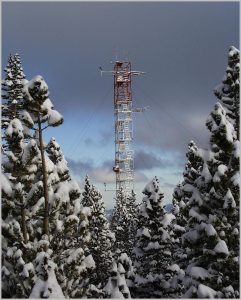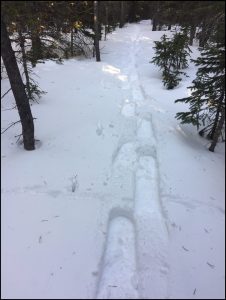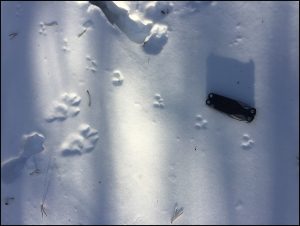I have a love-hate relationship with winter. As manager of the Niwot Ridge US-NR1 AmeriFlux site (Blanken et al., 1998-present), located in a subalpine forest on the east side of the Rocky Mountains, I experience all the seasons. In winter, I love the falling snow and seeing/feeling the powerful wind howling over a frozen landscape, but it can make the work more difficult. When angry, the wind is a screaming demon. The wind has been blowing in this way since these mountains formed 10,000s of years ago….it was this way for all the years that Indigenous people walked through these high-elevation forests, and when the first Europeans settlers/miners showed up around 300 years ago. In general, early human visitors must have avoided the high elevation mountains in winter. John Marr started making year-round meteorological measurements here in the 1950s (e.g., Marr, 1961)…though the landscape has changed since then, I’m sure some of the older trees still recall when that happened. John Marr had the foresight to create an elevation transect of measurements from the mountains to the plains (the so-called, A-1, B-1, C-1, and D-1 sites); several of these station locations are still used today and provide basic data that support long-term studies of climate change in the region.
After parking at the University of Colorado Mountain Research Station (MRS), there is a 3/4-mile and 300′ elevation climb to reach the trailer (near C-1). From the trailer to the 26-m tall US-NR1 main tower, is another 1/2 mile hike (or ski or snowshoe in winter) along a seldom-traveled forest trail. In winter, this often means breaking trail. As I park at MRS, the wind slams into the car…I’ve been up here 100s of times in winter, and this is one of those “windy” days. I check in with Kris Hess and chat with Jen Morse in the Marr Lab at the MRS before heading out. We share a kinship, being here in this place on this windy, cold winter day. It’s good to be alive…and away from my computer!
The air is crisp and cold. It’s a slow slog up to the trailer at C-1. After a quick rest and chat with Duane Kitzis from the NOAA Global Monitoring Laboratory in the trailer across the road, it’s onward along the trail to the main tower, dragging a CO2 calibration cylinder over the snow (a much better workout than the gym!). [Duane collects clean air at C-1 that is used in calibration gas cylinders for research groups around the world.] Back in 1997, Russ Monson, Andrew Turnipseed, and Dave Bowling found the US-NR1 tower location using a small airplane and tarps. They picked well. The location is at the ecotone between the spruce-fir and ponderosa pine forests (e.g., Monson, et al. 2002; Monson et al. 2010). Though there is steep terrain in the area, the tower itself it on the side of an ancient moraine that has a fairly gentle six-degree slope. The spruce-fir trees to the west are slightly taller and the forest is more open there. Some of the oldest trees are over 250 years old. Throughout the forest, there are stumps/remnants of trees cut down over 100 years ago (e.g., Burns, 2018).
As I break trail to get to the tower, I look for the moose tracks that are sometimes near the creek. Nothing today. As I walk, I think about the physical and ecological processes taking place all around me. As the wind screams, coherent structures and turbulence lurk at the top of the trees and snow devils pop up out of the forest. I thank the trees for absorbing all that momentum and protecting me. The trees swaying motion has recently been used by Mark Raleigh and collaborators to infer canopy interception of falling snow at US-NR1 (Raleigh, et al. 2022). There are plenty of snapped and broken trees scattered throughout the forest–they do not have an easy life. The snow that covers the ground is changing all the time (e.g., Burns, et al. 2014). Today, any falling snow is blown from the nearby mountain peaks and pulverized into small pellets by the wind. Looking up, the snow seems to be moving horizontally rather than falling downward to the ground. How much of the snow on the ground and trees is sublimating? How much is melting and then evaporating? On a day like today, there is likely not much melting going on….but on warmer days, both processes occur. Which one dominates? How can we measure that? Water isotopes? Things to ponder. Any measurements that provide more information are always encouraged and welcomed. In the soil underneath the snow, the microbes are happily unaware of the wind and cold. They continue to consume decaying plant material and release CO2 into the snowpack. Past research here (e.g., Monson et al. 2005, 2006; Bowling and Massman 2011) and other places has shown the snowpack contains high levels of CO2 as it diffuses from the ground, through the snow, and into the atmosphere (or it gets flushed out by the wind and/or related pressure forces that travel through the snowpack).
As I reach the tower, I decide that it’s a good day to stay on the ground; but I check for any cables that might have come loose high up on the tower. There is snow to be shoveled, gas cylinders to swap, and a few remote data loggers to visit. Over the years I have learned that it is best to batten down the hatches during the short days of winter. Not to try to do too much. I complete my tasks and head back the way I came. It’s mostly downhill, the trail has been cleared, and the cylinder I’m dragging back to the trailer at C-1 is empty. As I reach the car, I am tired. More tired than in past years. I know my days visiting this special place will not last forever. So, I try my best to savor and enjoy each visit. Satisfied in knowing that the data we are collecting will leave a record of the local climate and ecological processes of this place for many years to come.
References:
===========
Blanken, P.D., Monson, R.K., Burns, S.P., Bowling, D.R. and Turnipseed, A.A., 1998-present: Data and information for the AmeriFlux BASE US-NR1 Niwot Ridge Subalpine Forest (LTER NWT1) site, Ver. 19-5, AmeriFlux Management Project (AMP), Berkeley, CA: Lawrence Berkeley National Laboratory. https://doi.org/10.17190/AMF/1
Bowling, D.R., Massman, W.J., 2011: Persistent wind-induced enhancement of diffusive CO2 transport in a mountain forest snowpack. J. Geophys. Res. 116, G04006.
https://doi.org/10.1029/2011JG
Burns, S.P. 2018: The Influence of Warm-Season Precipitation on Water Cycling and the Surface Energy Budget within and just-above a Colorado Subalpine Forest in Mountainous Terrain: Measurements and Modeling , PhD Thesis, University of Colorado, Boulder, Colorado, 307 pp.
https://scholar.colorado.edu/c
Burns, S.P., Molotch, N.P., Williams, M.W., Knowles, J.F., Seok B., Monson, R.K., Turnipseed, A.A., and Blanken P.D., 2014: Snow temperature changes within a seasonal snowpack and their relationship to turbulent fluxes of sensible and latent heat. Journal of Hydrometeorology, 15, 117-142,
https://doi.org/10.1175/JHM-D-
Marr, J. W., 1961: Ecosystems on the east slope of the Front Range in Colorado, Series in Biology, No. 8, University of Colorado Press, Boulder, Colorado. 144 pp.
Monson, R.K., Prater, M.R., Hu, J., Burns, S.P., Sparks, J.P., Sparks, K.L., and Scott-Denton, L.E., 2010: Tree species effects on ecosystem water-use efficiency in a high-elevation, subalpine forest, Oecologia, 162, 491–504,
https://doi.org/10.1007/s00442
Monson, R.K., Burns, S.P., Williams, M.W., Delany, A.C., Weintraub, M. and Lipson, D.A., 2006: The contribution of beneath-snow soil respiration to total ecosystem respiration in a high-elevation, subalpine forest. Global Biogeochemical Cycles, 20, GB3030,
https://doi.org/10.1029/2005GB
Monson, R.K., Sparks, J.P., Rosenstiel, T.N., Scott-Denton, L.E., Huxman, T.E., Harley, P.C., Turnipseed, A.A., Burns, S.P., Backlund, B., and Hu, J., 2005: Climatic influences on net ecosystem CO2 exchange during the transition from wintertime carbon source to springtime carbon sink in a high-elevation, subalpine forest, Oecologia, 146, 130–147,
https://doi.org/10.1007/s00442
Monson, R.K., Turnipseed, A.A., Sparks, J.P., Harley, P.C., Scott-Denton, L.E., Sparks, K., and Huxman, T.E., 2002: Carbon sequestration in a high-elevation, subalpine forest, Global Change Biology, 8, 459–478,
https://doi.org/10.1046/j.1365
Raleigh, M.S., Gutmann, E.D., Van Stan, J.T.II., Burns, S.P., Blanken, P.D., and Small, E.E., 2022: Challenges and capabilities in estimating snow mass intercepted in conifer canopies with tree sway monitoring. Water Resources Research, 58, e2021WR030972.
https://doi.org/10.1029/2021WR






No Comments
Be the first to start a conversation